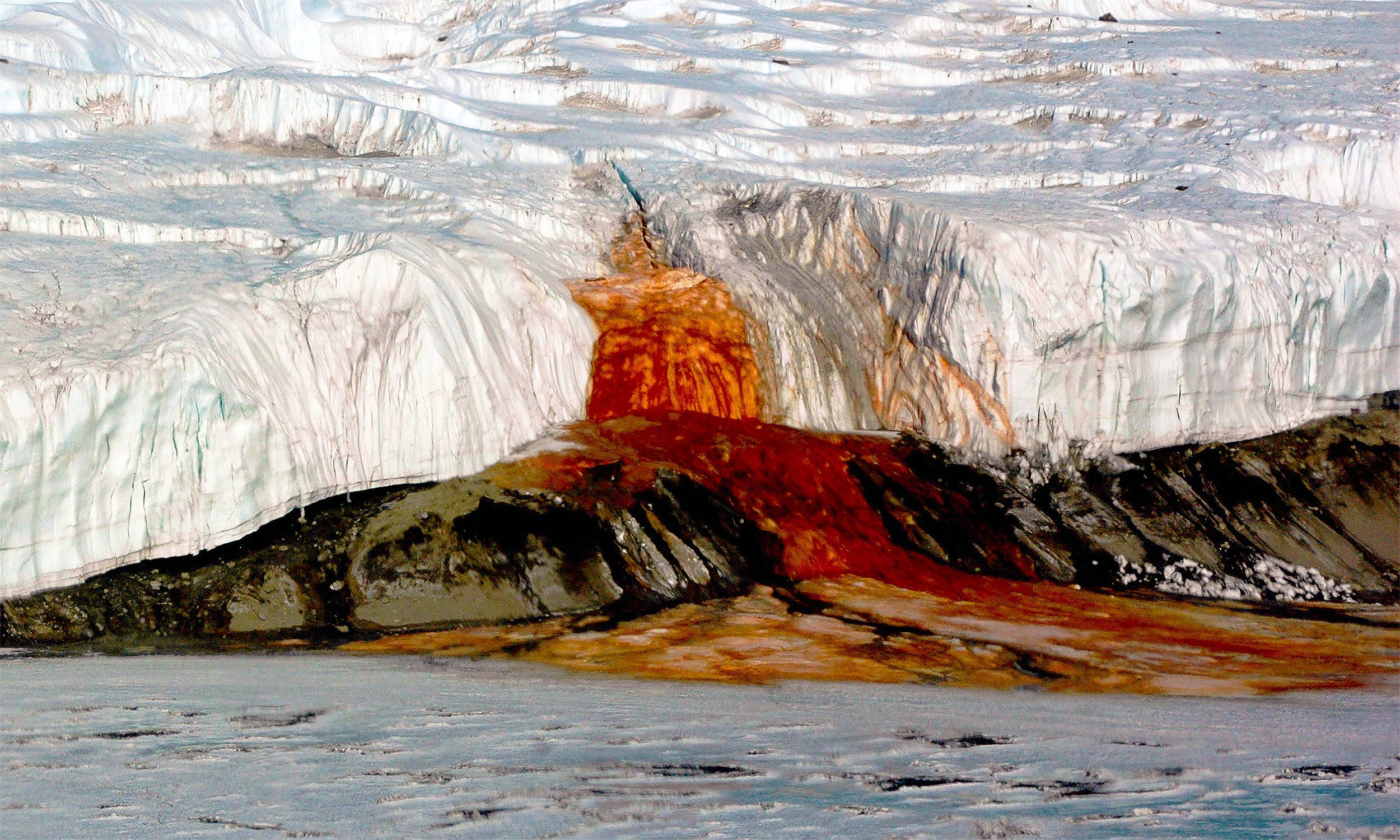
First discovered in 1911 by Australian geologist Griffith Taylor, Blood Falls has continued to intrigue explorers and researchers alike. This striking crimson phenomenon spills from the pristine white expanse of Taylor Glacier located in East Antarctica, creating dramatic splashes on the icy landscape below.
For over a century, this peculiar display has sparked curiosity worldwide.
According to Chris Carr, a glaciologist at Los Alamos National Laboratory (LANL) and the primary author of a recent study, scientists are still on the quest to find the exact cause of this waterfall’s unpredictable flow.
Liquid Water at Blood Falls
Although Blood Falls does not flow continuously throughout the year, it remains remarkable as the water beneath the glacier retains its liquid state, even amidst harsh cold temperatures.
Research has traced this saline water to a concealed reservoir beneath Taylor Glacier, where it retains warmth far better than standard freshwater.
The elevated salinity decreases the freezing point, allowing the water to remain fluid even in severe Antarctic conditions.
Some researchers speculate that this hidden reservoir may be an ancient remnant of marine water, potentially trapped for millions of years. This water makes its way through fissures and channels created in the glacier and emerges onto the surface at irregular intervals.
A Bizarre Hue
While its appearance may evoke fear, the striking color is not due to actual blood. Instead, it is the product of oxidation, a chemical reaction occurring when iron-rich brine comes into contact with oxygen in the atmosphere.
Each eruption causes additional iron to react, staining the ice with a rusty hue.
Earlier theories suggested that red algae were responsible for this vivid color, but those ideas have since been ruled out.
Thorough chemical examinations have identified iron compounds that darken the water’s flow, giving it a deep reddish tint.
A Seasonal Flow Mystery
Winter in Antarctica is brutal, with temperatures plummeting well below freezing.
Scientists were taken aback to observe that Blood Falls continued to flow even under these frigid conditions.
There was anticipation that capturing the waterfall on film would unveil some seismic activity associated with ice cracks. Although sensors did register minimal shifts, none were correlated with the brine flow.
This left experts puzzled. Erin Pettit, a glaciologist at Oregon State University and co-author of several studies on Blood Falls, noted this peculiarity:
“We were brainstorming the most extraordinary possibilities because nothing seemed to add up and our data was limited,” Pettit noted.
The observation of winter flows has led researchers to ponder whether changes occurring deep within the glacier might play a role.
Life Beneath the Ice
The brine exiting Blood Falls is not devoid of life. Researchers have discovered that it contains microorganisms adapted to thrive in environments with scarce sunlight and nutrients locked beneath layers of ice.
Studies indicate that certain microbes can utilize iron and sulfur compounds for nourishment, deriving energy from these chemical reactions rather than relying on sunlight.
Many scientists see parallels between these microbes and potential forms of life that might exist on icy celestial bodies elsewhere.
The combination of a protective icy cover and saline subglacial waters hints at how life could endure in secluded environments far away from the Sun.
Blood Falls, Glaciers, and Other Worlds
The presence of brine in such a frigid location challenges conventional beliefs about the limitations imposed by cold glaciers.
“Researchers had previously assumed any water would freeze completely, but Taylor Glacier is recognized as the coldest glacier that maintains a continuous flow of liquid water,” Pettit stated in a press release.
These findings enhance our broader comprehension of subglacial hydrology.
Data collected at Blood Falls can inform future inquiries into other cold glaciers on Earth and inspire new hypotheses regarding potential habitats beneath the ice caps on Mars or Europa, one of Jupiter’s moons.
Ongoing Mysteries at Blood Falls
The precise causes of the periodic outbursts remain unclear. Some suggest that internal pressure builds within the subglacial reservoir until the water forces its way through a weak point.
Others speculate that minuscule shifts in the glacier’s movement may open narrow channels that allow the brine to escape.
Regardless, each surge of crimson liquid serves as a reminder of the unpredictability of glacial processes.
Advancements in technology, including specialized radar and melting probes, are aiding scientists in gaining clearer insights into these concealed systems.
Every time the red water emerges, further observations may unravel the mystery of what triggers each release.
For now, Blood Falls continues to stand as a striking emblem of Earth’s endless surprises.
The Significance of Research on Blood Falls
The secrets of Antarctica extend far beyond the vivid red stream in Taylor Valley. Investigating Blood Falls requires significant determination, funding, and adherence to strict protocols when working in polar environments.
Setting up field camps, transporting equipment, and installing sensitive instruments must be done meticulously to avoid contaminating the pristine ecosystem or jeopardizing the safety of research teams.
Although this waterfall may appear as a mere trickle within a vast frozen landscape, it encapsulates a much larger narrative of geological resilience.
The saline discharge suggests an expansive underground water network and remarkable evidence of life persistence where few would expect it.
—–
Image Credit: National Science Foundation (NSF)/Peter Rejcek
This study has been published in the Journal of Geophysical Research: Earth Surface.
—–
Enjoyed this piece? Subscribe to our newsletter for engaging articles, exclusive insights, and the latest updates.
Explore our content on EarthSnap, a complimentary app created by Eric Ralls in partnership with Earth.com.
—–









